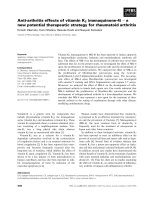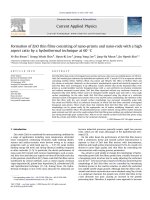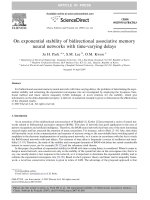Derivatives of pyrazolo1,5 a1,3,5triazines as enzyme inhibitors with potential therapeutic value
Bạn đang xem bản rút gọn của tài liệu. Xem và tải ngay bản đầy đủ của tài liệu tại đây (1.11 MB, 216 trang )
DERIVATIVES OF PYRAZOLO[1,5-a][1,3,5]TRIAZINES
AS ENZYME INHIBITORS WITH
POTENTIAL THERAPEUTIC VALUE
SUN LINGYI
(B. Sc. (Pharm.)), Shanghai Jiao Tong Univ.
A THESIS SUBMITTED
FOR THE DEGREE OF DOCTOR OF PHILOSOPHY
DEPARTMENT OF PHARMACY
NATIONAL UNIVERSITY OF SINGAPORE
2013
i
ACKNOWLEDGEMENTS
I wish to express my heartfelt gratitude to my supervisor Assoc. Prof. Chui
Wai Keung, Head, Department of Pharmacy, for his enormous and continuous
support throughout my PhD study. I sincerely appreciate him for granting me
such a great freedom to work independently while at the same time providing
valuable suggestions. The most important thing I have learned from him is
how to think critically when setting up the experiments, which would benefit
me a lot in my future career.
This project was supported by NMRC Grant R-148-000-102-275. Thanks to
Assoc. Prof. Chan Sun Yung, who was the head of department during large
portion of my PhD study, for providing me the necessary facilities to finish
this project. Thanks to National University of Singapore for providing me the
research scholarship.
Thanks to Dr. Anton Dolzhenko for his guidance and precious advice in my
chemistry work.
My gratitude also goes to Dr. Gigi Chiu Ngar Chee, Ms. Tan Bee Jen and Ms.
Gan Fei Fei for their kind help in my cell work. Their precious advice helped
me solve lots of problems encountered in the cell work.
Special thanks are extended to lab technologists Ms. Ng Sek Eng and Ms. Lye
Pey Pey for their support in processing my orders.
I also want to thank all my labmates, Dr. Yang Hong, Dr. Ong Pauline, Dr.
Sachdeva Nikhil, Dr. Bera Hriday, Ms. Ng Hui Li, Mr. Li Ka Chun and FYP
student Ms. Li Jia Rong and Ms. Ang Xiao Hui for your daily help, and I
would not forget your nice collaboration during those safety audits.
My dear friends, Mr. Li Jian, Dr. Sun Feng, Dr. Zhang Yaochun, Dr. Wang
Likun, Dr. Li Lin, Dr. Wang Zhe, Mr. Li Fang, Ms. Yang Shili, Mr. Liu
Yuanjie, Mr. Sun Longwei, and Mr. Tan Kuan Boone, it was so lucky for me
to recognize all of you! The time we spent together in playing War Craft Ⅲ
or basketball was so precious that I would memorize forever.
I am grateful to my dear parents and relatives. I understand that it is difficult
for my parents to make a decision that let their son go aboard, and I sincerely
appreciate your respect towards my own choice. In addition, I also want to
thank my dear girlfriend Ms. Chen Xiao for accompanying me in the past
three years. I did not get significant results before our encounter thus I believe
it was you who brought me the good fortune.
This last paragraph is for those who have ever helped me during the past four
years but not mentioned above due to the limited space: Thank you so much!
ii
CONTENTS
PAGE
ACKNOWLEDGEMENTS i
SUMMARY v
ABBREVIATIONS viii
LIST OF TABLES x
LIST OF FIGURES xii
LIST OF SCHEMES xiv
1. Introduction 1
1.1 A brief overview of enzyme inhibitors as drugs 2
1.1.1 Oxidoreductases (EC 1) as targets for developing enzyme
inhibitors as drugs 3
1.1.2 Transferases (EC 2) as targets for developing enzyme
inhibitors as drugs 6
1.1.3 Hydrolase (EC 3) as targets for developing enzyme inhibitors
as drugs 8
1.1.4 Lyases (EC 4) as targets for developing enzyme inhibitors as
drugs 9
1.2 Thymidine phosphorylase as a target for developing enzyme
inhibitors possessing therapeutic values 12
1.2.1 Physiological functions of thymidine phosphorylase
13
1.2.2 Pathological functions of thymidine phosphorylase
14
1.2.2.1 Thymidine phosphorylase in cancers 14
1.2.2.2 Thymidine phosphorylase in other diseases 20
1.2.3 Thymidine phosphorylase inhibitors and their potential
therapeutic values 22
1.2.3.1 Pyrimidine derivatives as inhibitors of thymidine
phosphorylase 23
iii
1.2.3.2 Purine derivatives as inhibitors of thymidine
phosphorylase 29
1.2.3.3 Thymidine phosphorylase inhibitors based on other
structures 31
1.2.3.4 Therapeutic potential of inhibitors of thymidine
phosphorylase 32
1.3 Synthesis of pyrazolo[1,5-a][1,3,5]triazines 34
1.3.1 Synthesis of pyrazolo[1,5-a][1,3,5] triazines from pyrazole
scaffold 35
1.3.2 Synthesis of pyrazolo[1,5-a][1,3,5] triazines from
1,3,5-triazine scaffold 42
1.3.3 Synthesis of pyrazolo[1,5-a][1,3,5] triazines by concurrent
formation of both the 1,3,5-triazine and pyrazole rings 43
1.3.4 Synthesis of pyrazolo[1,5-a][1,3,5] triazines by ring
transformation reactions 44
1.4 Biological activity of pyrazolo[1,5-a][1,3,5]triazines 47
1.4.1 Enzyme inhibitors containing the
pyrazolo[1,5-a][1,3,5]triazine scaffold 47
1.4.2 Other biological activities 51
1.5 Hypothesis and objectives 54
1.5.1 Hypothesis 54
1.5.2 Objectives 57
2. Fused bicyclic pyrazolo[1,5-a][1,3,5]triazine derivatives as inhibitors of
thymidine phosphorylase 60
2.1 Chemistry 62
2.2 Thymidine phosphorylase inhibitory activity 77
2.3 Enzyme inhibition kinetic studies 83
2.4 Antiangiogenic potential studies 85
2.4.1 Cytotoxicity study of selected TP inhibitors against
MDA-MB-231 86
iv
2.4.2 Inhibition of MMP-9 secretion in MDA-MB-231 by selected
TP inhibitors 89
2.5 Summary 91
3. 5-Chlorouracil-linked-pyrazolo[1,5-a][1,3,5]triazines as inhibitors of
thymidine phosphorylase 94
3.1 Chemistry 96
3.2 Thymidine phosphorylase inhibitory activity 103
3.3 Enzyme inhibition kinetics studies 109
3.4 Antiangiogenic potential studies 112
3.4.1 Cytotoxic studies of selected TP inhibitors against
MDA-MB-231 112
3.4.2 Inhibition of MMP-9 secretion in MDA-MB-231 by selected
TP inhibitors 114
3.5 Summary 118
4. Conclusion and Future work 120
4.1 Conclusion 121
4.2 Future work 129
5. Materials and methods 133
5.1 Chemistry 134
5.1.1 Preparation and characterization of intermediates 135
5.1.2 Preparation and characterization of target compounds 152
5.2 Biological tests 178
5.2.1 Evaluation of inhibitory activity against thymidine
phosphorylase 178
5.2.2 Thymidine phosphorylase inhibition kinetic studies
179
5.2.3 MTT assay 180
5.2.4 Gelatine zymography 181
Bibliography 183
v
SUMMARY
Thymidine phosphorylase (TP) is an enzyme that promotes tumour growth and
metastasis thus is an attractive druggable target. Currently, the most potent TP
inhibitors are pyrimidine derivatives; although some purine based inhibitors
have also been reported but their potency against TP is still weak. The goal of
this project was to develop new TP inhibitors that are analogues of purine. It
was hypothesized that the pyrazolo[1,5-a][1,3,5]triazine scaffold equipped
with a homophthalimide moiety would exhibit TP inhibitory activity through
proper structural modifications. In addition, it was also hypothesized that
compounds consisting of both pyrimidine moiety and purine related moiety
could inhibit TP through dual site interaction.
In particular, to test the first hypothesis, a total of 59
1,3-dihydro-pyrazolo[1,5-a][1,3,5]triazin-2,4-diones as well as their isosteric
2- thioxo analogues were synthesized and subjected to an in vitro enzyme
bioassay. All target compounds were obtained in good yields (32%-94%) via a
synthetic approach that required annulation of the 1,3,5-triazine ring onto
substituted 3-amino pyrazoles. Results of the subsequent enzyme test showed
that although 1,3-dihydro-pyrazolo[1,5-a][1,3,5]triazin-2,4-diones were not
active against TP, most of their isosteric 2- thioxo analogues exhibited TP
inhibitory activity with IC
50
values ranging from 87.3µM to 40nM. The best
compound 17r showed an IC
50
value of 40nM which is around 800 times more
vi
potent than the lead compound 7DX. Therefore, the first hypothesis was
proven to be partially true. Further enzyme inhibitory kinetic studies revealed
that 17r was a non-competitive inhibitor, suggesting that it might bind to an
allosteric site.
To test the second hypothesis, 31 compounds consisting of both pyrimidine
moiety and purine moiety designed as
3H-2-(5-chlorouracil-6-methylthio)-pyrazolo[1,5-a][1,3,5]triazin-4-ones were
synthesized and evaluated by the in vitro enzyme assay. A multiple-step
convergent synthetic scheme was devised to generate the target compounds in
good yields (40%-96%). The intermediate 5-chloro-6-chloromethyluracil was
synthesized by a 4-step reaction and then coupled with
1,3-dihydro-pyrazolo[1,5-a][1,3,5]triazin-2-thioxo-4-ones to yield the target
compounds. Subsequent enzyme tests showed that this type of compounds
was active against TP with IC
50
values ranging from 67.8µM to 0.36µM, and
the second hypothesis in this study was proven to be true. The best compound
in this series, 24r, was subjected to enzyme inhibitory kinetic studies. Results
revealed that 24r demonstrated a mixed-type of enzyme inhibition kinetics,
thus suggesting that it might potentially bind at two different sites on the
enzyme.
In addition, a total of 26 compounds with IC
50
values less than 10µM were
selected from the two series of compounds synthesized to explore their
vii
potential antiangiogenic properties. They were subjected to a gelatin
zymography assay that evaluated their potential suppressive effect on the
secretion of the angiogenic factor MMP-9 in cancer cells. Based on the results
obtained, 9 compounds among them did suppress the secretion of MMP-9 thus
might possess some therapeutic value in antiangiogenesis.
(Words-458)
viii
ABBREVIATIONS
2DDR 2-Deoxy-D –ribose
2DDR-1P 2-Deoxy-D –ribose-1-phosphate
2DLR 2-Deoxy-L-ribose
6A5BP 6-Amino-5-bromo-3H-pyrimidin-4-one
6A5BU 6-Amino-5-bromouracil
6A5CU 6-Amino-5-chlorouracil
6AT 6-Aminothymine
7DX 7-Deazaxanthine
BNIMU 5-Bromo-2-nitro-imidazolylmethyluracil
BPMU 5-Bromo-6-(pyrrolidinylmethyl)uracil
CAM Chorio-allantoic membrane
CB Cannabinoid
CDK2 Cyclin-dependent kinase 2
CIIMU 5-Chloro-6-[(2-iminoimidazolidinyl)methyl]uracil hydrobromide
CIPMP
5-Chloro-6-[1-(2-iminopyrrolidinyl)methyl]-3H-pyrimidin-4-one
hydrochloride
CNIMU 5-Chloro-2-nitro-imidazolylmethyluracil
CNS Central nervous system
CRF Corticotropin-releasing factor
DISC Death-inducing signaling complex
dNTPs Deoxyribonucleoside triphosphates
ECM Extracellular matrix
EPC Endothelial progenitor cells
FAK Focal adhesion kinase
ix
HCMM
Hydrazine carboxamide 2-[(1-methyl-2,5-dioxo-4-pentyl
-4-imidazolidinyl)methylene]
HUVEC Humbilical vein endothelial cells
MIC Minimal inhibitory concentration
MIMC
3- [(3-Methoxy-4-methylphenyl) imino] methyl-4H-chromen
-4-one
MMP Matrix metalloproteinase
MNEC Maximal non-effective concentration
MNGIE Mitochondrial neurogastrointestinal encephalopathy
MPIC 3-(2-Methylphenyl) isocoumarin
MW Molecular weight
PDE Phosphodiesterases
PD-ECGF Protein platelet-derived endothelial cell growth factor
PMA Phorbol 12-myristate 13-acetate
RA Reumatoid arthritis
SAR Structure activity relationship
SCO2 Synthesis of cytochrome c oxidase 2
TFT Trifluorothymidine
TP Thymidine phosphorylase
TPI 5-Chloro-6-[1-(2-iminopyrrolidinyl)methyl]uracil hydrochloride
TPIPA 3-(2,4,5-Trioxo-3-phenylethyl-imidazolodin-1-yl)propionamide
TS Thymidylate synthase
VEGF Vascular endothelial growth factor
XO
Xanthine oxidase
x
LIST OF TABLES
TABLE
PAGE
1
Various roles of TP in diseases. 22
2
Selection of synthetic methods for introducing
substituents to pyrazolo[1,5-a][1,3,5]triazine at different
positions.
46
3
Yields of 7-substituted 1,3-dihydro-pyrazolo[1,5-a]
[1,3,5]triazin-2,4-diones.
71
4
Yields of 8-substituted 1,3-dihydro-pyrazolo[1,5-a]
[1,3,5]triazin-2,4-diones.
72
5
Yields of 7-substituted 1,3-dihydro-pyrazolo[1,5-a]
[1,3,5]triazin-2-thioxo-4-ones.
75
6
Yields of 8-substituted 1,3-dihydro-pyrazolo[1,5-a]
[1,3,5]triazin-2-thioxo-4-ones.
76
7
TP inhibitory activity of 7-substituted 1,3-dihydro-
pyrazolo[1,5-a][1,3,5]triazin-2-thioxo-4-ones.
81
8
TP inhibitory activity of 8-substituted 1,3-dihydro-
pyrazolo[1,5-a][1,3,5]triazin-2-thioxo-4-ones.
82
9
Cell viability of selected 1,3-dihydro-pyrazolo[1,5-a]
[1,3,5]triazin-2-thioxo-4-ones.
88
10
Yields of 7-substituted 2-(5-chloro-1,3-dihydro
pyrimidin-2,4-dioxo-6-ylmethylthio)pyrazolo[1,5-a]
[1,3,5]triazin-4(3H)-ones.
101
11
Yields of 8-substituted 2-(5-chloro-1,3-dihydro
pyrimidin-2,4-dioxo-6-ylmethylthio)pyrazolo[1,5-a]
[1,3,5]triazin-4(3H)-ones.
102
12
TP inhibitory activity of 7-substituted 2-(5-chloro-1,3-
dihydropyrimidin-2,4-dioxo-6-ylmethylthio)pyrazolo
[1,5-a][1,3,5]triazin-4(3H)-ones.
105
13
TP inhibitory activity of 8-substituted 2-(5-chloro-1,3-
dihydropyrimidin-2,4-dioxo-6-ylmethylthio)pyrazolo
[1,5-a][1,3,5]triazin-4(3H)-ones.
106
14
Cell viability of selected 2-(5-chloro-1,3-dihydro
pyrimidin-2,4-dioxo-6-ylmethylthio)pyrazolo[1,5-a]
113
xi
[1,3,5]triazin-4(3
H
)-ones.
15
Comparison between two series of TP inhibitors. 127
xii
LIST OF FIGURES
FIGURE
PAGE
1
Enzymatic reaction catalyzed by thymidine
phosphorylase.
12
2
The active site of TP. 13
3
7DX and proposed substituted pyrazolo[1,5-a][1,3,5]
triazines.
54
4
Proposed TP inhibitors possessing both the pyrimidine
moiety and the purine moiety.
56
5
Dissection analysis of fused bicyclic pyrazolo[1,5-a]
[1,3,5]triazines.
62
6
Retrosynthesis of fused bicyclic pyrazolo[1,5-a][1,3,5]
triazines.
63
7
Figure 7. Craig plot for para-substituents.
83
8
Lineweaver-Burk plots of thymidine phosphorylase
inhibition by 15l (a) and 17r (b) prepared at different
concentrations.
85
9
Gelatine zymography screening of TPI, 7DX and
selected1,3-dihydro-pyrazolo[1,5-a][1,3,5]triazin-2-thio
xo-4-ones at the concentrations of 100µM.
90
10
Concentration dependent studies for 17q and 17r at the
concentrations of 100µM, 50µM, 25µM, and 10µM.
91
11
Densitometric analysis of band intensities of
corresponding concentrations for 17q and 17r,
normalized to respective controls.
91
12
Design of the linker.
96
13
Dissection analysis of 5-chlorouracil linked
pyrazolo[1,5-a][1,3,5]triazines.
96
14
Retrosynthesis of 5-chlorouracil linked pyrazolo[1,5-a]
[1,3,5]triazines.
97
15
Lineweaver-Burk plots of thymidine phosphorylase
inhibition by compound 23j (a) and 24r (b) prepared at
different concentrations.
111
16
Gelatine zymography screening of selected
114
xiii
2-(5-chloro-1,3-dihydropyrimidin-2,4-dioxo-6-ylmethylt
hio) pyrazolo[1,5-a][1,3,5]triazin-4(3H)-ones at the
concentrations of 100µM.
17
Concentration dependent studies for 23g, 23h and 23j at
the concentrations of 100µM, 50µM, 25µM, and 10µM.
115
18
Densitometric analysis of band intensities of
corresponding concentrations for 23g, 23h and 23j,
normalized to respective controls.
116
19
Concentration dependent studies for 24i, 24j, 24m and
24r at the concentrations of 100µM, 50µM, 25µM, and
10µM.
117
20
Densitometric analysis of band intensities of
corresponding concentrations for 24i, 24j, 24m and 24r,
normalized to respective controls.
117
21
SAR of
fused bicyclic pyrazolo[1,5-
a
][1,3,5]triazines. 123
22
The most potent compound in the 1,3-dihydro-pyrazolo
[1,5-a][1,3,5]triazin-2-thioxo-4-one series.
123
23
SAR of 5-chlorouracil-linked-pyrazolo[1,5-a][1,3,5]
triazines.
124
24
The most potent compound in the 2-(5-chloro-1,3-
dihydropyrimidin-2,4-dioxo-6-ylmethylthio)pyrazolo
[1,5-a][1,3,5]triazin-4(3H)-one series.
124
25
Proposed new TP inhibitors. 130
xiv
LIST OF SCHEMES
SCHEME
PAGE
1
Synthesis of 1,2,3,4-tetrahydropyrazolo[1,5-a][1,3,5]
triazines through four-bond cyclization.
36
2
Synthesis of 4-aryloxy-2,2-dimethyl-2,3-
dihydropyrazolo[1,5-a][1,3,5]triazines through
three-bond cyclization.
36
3
Synthesis of 2,4-diarylpyrazolo[1,5-a][1,3,5]triazines
through two-bond cyclization.
37
4
Synthesis of pyrazolo[1,5-
a
][1,3,5]triazines
through two-bond cyclization.
38
5
Synthesis of 2-amino-4-thioxopyrazolo[1,5-a][1,3,5]
triazines through two-bond cyclization.
38
6
Synthesis of fused tricyclic benzopyrazolo[1,5-a]
[1,3,5]triazine ring system through two-bond
cyclization.
39
7
Synthesis of 2,4-dioxo-7-phenylpyrazolo[1,5-a][1,3,5]
triazine through two-bond cyclization.
40
8
Synthesis of 4-amino-2-methyl-7-phenylpyrazolo
[1,5-a][1,3,5]triazine through two-bond cyclization.
40
9
Synthesis of 4-amino-7-methyl-2-oxopyrazolo[1,5-a]
[1,3,5]triazine through one-bond intramolecular
cyclization.
41
10
Synthesis of 5-aza-9-deazahypoxanthine
through one-bond intramolecular cyclization.
42
11
Synthesis of 2,4-diamino-1,3,5-triazino[1,2-b]
indazoles.
43
12
Synthesis of 7-oxo-4-thioxopyrazolo[1,5-a][1,3,5]
triazines.
43
13
Pyrazolo[1,5-
a
][1,3,5] triazine scaffold generated by
transformation of the 1,3,5-thiadiazine ring.
44
14
Pyrazolo[1,5-a][1,3,5] triazine scaffold generated by
transformation of the 1,2,3-triazine ring.
45
xv
15
Synthesis of 4-aryl-1H-pyrazol-3-ylamines. 65
16
Synthesis of 5-Phenyl-1H-pyrazol-3-ylamine. 67
17
Synthesis of 1,3-dihydro-pyrazolo[1,5-a][1,3,5]triazin
-2,4-diones.
69
18
Synthesis of 1,3-dihydro-pyrazolo[1,5-a][1,3,5]triazin
-2-thioxo-4-ones.
74
19
Synthesis of 5-chloro-6-chloromethyluracil. 98
20
Synthesis of 2-(5-chloro-1,3-dihydropyrimidin-2,4-
dioxo-6-ylmethylthio)pyrazolo[1,5-a][1,3,5]triazin-4
(3H)-ones.
100
1
1. Introduction
2
1.1 A brief overview of enzyme inhibitors as drugs
Enzyme inhibitors refer to a group of molecules which block the catalytic
activity of enzymes. According to interacting mechanisms with their targets,
enzyme inhibitors can be categorized into either reversible inhibitors which
bind non-covalently with the enzymes or irreversible inhibitors which interact
with enzymes via covalent bond formation. Based on their binding sites,
reversible inhibitors can be further divided into subcategories such as
competitive inhibitors, mixed type inhibitors, non-competitive inhibitors and
uncompetitive inhibitors. In particular, a competitive inhibitor can bind to the
corresponding substrate binding site; a mixed type inhibitor can bind to an
allosteric siteat the same time affecting the binding of the substrate; a
non-competitive inhibitor can bind to allosteric site but do not affect the
binding of the substrate; an uncompetitive inhibitor can only bind to the
corresponding substrate-enzyme complex. The inhibitory effect of a
competitive inhibitor can be completely overcome once the substrate
accumulated to a certain concentration level. Butthe inhibitory effect of other
types of inhibitors can not be completely overcome, thus they possess an
advantage over competitive inhibitors from this aspect. The approach to
design an enzyme inhibitor is to mimic the structure of the substrate, therefore
most enzyme inhibitors are competitive inhibitors.
3
Many enzyme inhibitors are antimetabolites, and they act by interfering with
the essential metabolic pathways which may lead to disruption of normal
cellular functions. As antimetabolites often appear structurally similar to
essential metabolites, they are mistakenly recognized by the enzymes, leading
to either blockage of the enzymes or the generation of non-functional products.
One such example is theantifolate-methotrexate. It is structurally similar to
dihydrofolate, and hence it can inhibit the enzyme dihydrofolate reductase.
Since many disease processes are found to be associated with the metabolite
imbalance, designing enzyme inhibitors as antimetabolites has been
considered as an efficient strategy for the drug development in some cases.
Many different types of enzymes involved in the regulation of metabolism
have been targeted for the development of inhibitors to be used as drugs. Some
representatives, sorted by enzyme categories, are described below.
1.1.1 Oxidoreductases (EC 1) as targets for developing enzyme
inhibitors as drugs
Oxidoreductase is an enzyme which catalyzes the transfer of electrons from an
electron donor (reductant) to an electron acceptor (oxidant). Some examples of
which oxidoreductases are used as targets to develop drugs are provided
below.
Aldose reductase, which is involved in the sorbitol pathway, plays an
important role in sorbitol accumulation thus is responsible for retinopathy and
4
neuropathy in people with diabetes. Ranirestat is an aldose reductase inhibitor
used in the treatment of diabetic neuropathy.
1
5-Alpha-reductase, which catalyzes the conversion of testosterone to
dihydrotestosterone, is involved in several diseases including prostatic
hyperplasia, lower urinary tract symptoms, androgenic alopecia as well as
prostate cancer. A representative 5-alpha-reductase inhibitor namely
finasteride has been clinically used for the treatment of benign prostatic
hyperplasia and male pattern baldness.
2, 3
N
H
O
NH
H
H
H
H
O
Finasteride
Monoamine oxidase, which deaminates monoamine neurotransmitters such as
dopamine, is considered as a druggable target in the treatment of several
diseases including panic disorder, atypical depression as well as post-traumatic
stress disorder. Safrazine is a monoamine oxidase inhibitor used as an
antidepressant.
4
N
N
O
O
F
Br
HN
O
O
Ranirestat
5
O
O
H
N
NH
2
Safrazine
Dihydrofolate reductase, which catalyzes the reduction of dihydrofolic acid to
tetrahydrofolic acid, is closely associated with cell proliferation thus served as
an important target in the cancer treatment. Dihydrofolate reductase inhibitor
such as methotrexate, developed in the 1960s, has been widely applied
clinically as antitumor agents even today.
5
5-Lipoxygenase, which transforms essential fatty acids into leukotrienes, is an
established target for pharmaceutical intervention in asthma. Zileuton is an
orally active 5-lipoxygenase inhibitor which is used for the maintenance
treatment of asthma.
6
S
N
HO
NH
2
O
H
Zileuton
Aromatase is an enzyme that synthesizes estrogen. As estrogen is essential for
the growth of breast and ovarian cancers, it has been proposed that aromatase
N
N N
N
NH
2
H
2
N
N
Me
CONH-L-Glu
Methotrexate
6
inhibitors possess therapeutic value in breast cancer or ovarian cancer
treatment. Representative is exemestane.
7
H
H
H
O
O
Exemstane
Ribonucleotide reductase, which plays a key role in the formation of
deoxyribonucleotides, is closely related to the growth of tumors. Triapine, a
ribonucleotide reductase inhibitor, is being investigated for the treatment of
cancer.
8
N
NH
2
N
H
N S
NH
2
Triapine
1.1.2 Transferases (EC 2) as targets for developing enzyme inhibitors as
drugs
The function of transferase is to catalyze the transfer of a functional group
from one donor molecule to an acceptor molecule. Several examples of using
transferases as targets for the drug design are listed below.
Catechol-O-methyl transferase is an enzyme that degrades dopamine, and it
serves as a target for drugs used in the treatment of Parkinson’s disease. A
7
catechol-O-methyl transferase inhibitor namely entacapone has served as the
therapeutic agent for the treatment of Parkinson’s disease.
9
N
OH
HO
O
2
N
O
N
Entacapone
Dihydropteroate synthase, which is not expressed in the human body,
produces dihydropteroate in bacteria, thus is an ideal target for sulfonamide
antibiotics of which sulfamethoxazole is an example.
10
S
N
H
O
N
H
2
N
OO
Sulfamethoxazole
Reverse transcriptase, which belongs to the nucleotidyltransferase family, can
add free nucleotides to the 3’end of the newly forming DNA strand. This
enzyme transcribes the single-stranded viral RNA genome into the
corresponding double-stranded viral DNA, thus it is crucial for the
proliferation of virus, eg. HIV. Therefore, a reverse-transcriptase inhibitor
namely zidovudine has been applied in the clinical treatment of HIV
infection.
11, 12
8
N
NH
O
O
O
HO
N
3
Zidovudine
Tyrosine kinases that catalyze the transfer of a phosphate group from ATP to a
protein thus activating a particular signal pathway are considered as important
targets in cancer chemotherapy. Imatinib, which inhibits a receptor tyrosine
kinase, has been used to treat chronic myelogenous leukemia.
13
HN
O
N
N
HN N
N
N
Imatinib
1.1.3 Hydrolase (EC 3) as targets for developing enzyme inhibitors as
drugs
Hydrolases are a type of enzymes which catalyze the hydrolysis of their
corresponding substrates. A few examples of drugs which are enzyme
inhibitors of hydrolases are provided below.
Acetylcholinesterase which hydrolyzes the neurotransmitter acetylcholine is
an established target in the treatment of a range of central nervous diseases.
9
For example, Donepezil, an inhibitor of acetylcholinesterase, is indicated for
improving cognitive function in Alzheimer’s disease.
14, 15
N
O
O
O
Donepezil
Viral neuraminidase which cleaves sialic acid groups from glycoproteins plays
an important role in the replication of the influenza virus. A neuraminidase
inhibitor namely zanamivir has been used clinically in the prophylaxis or
treatment of influenza.
16
O
HO
OH
HO
HN
O
HN
HN
NH
2
COOH
Zanamivir
1.1.4 Lyases (EC 4) as targets for developing enzyme inhibitors as drugs
Lyases refer to those enzymes which catalyze the breakage of various bonds in
their corresponding substrates via means other than hydrolysis and oxidation.
Aromatic-L-amino-acid decarboxylase is a lyase involved in the biosynthesis
of dopamine. Inhibiting this enzyme in the body periphery would cause the









